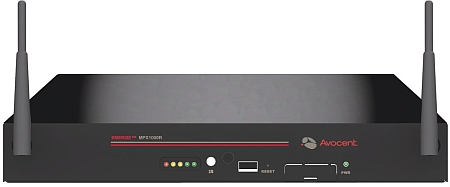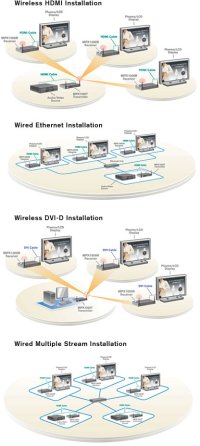Device Profile: Avocent MPX1000 HD media extender
Sep 27, 2006 — by LinuxDevices Staff — from the LinuxDevices Archive — 2 views Avocent has announced a Linux-based media extender aimed at presentation and signage applications. The MPX1000 can extend audio and HD video content from one or more sources to up to eight synchronized display devices, over wired or wireless Ethernet, according to the company.
Avocent has announced a Linux-based media extender aimed at presentation and signage applications. The MPX1000 can extend audio and HD video content from one or more sources to up to eight synchronized display devices, over wired or wireless Ethernet, according to the company.

Avocent MPX1000 receiver
(Click to enlarge)
(Click to enlarge)  Typical configurations (Click to enlarge) |
Although best known for its KVM (keyboard/video/mouse server) products, Avocent offers a full line of audio/video connectivity and extension products.
The MPX1000 system actually combines several Linux-based systems. It requires at least one MPX1000T transmitter, which can be attached to video sources via DVI-D, or with optional modules, via HDMI (high-definition multimedia interface) or VGA.
The transmitter relays audio and video content — including computer video up to 1254 x 768, or 720p/1080i HD video — to up to eight MPX1000R receivers (pictured top of page). The receivers are connected via 10/100 Ethernet, or by 802.11a WiFi, to which a proprietary link-layer has been added, presumably to add synchronization capabilities.
The receivers, in turn, can be connected to display devices with DVI-D ports, or, with optional modules, HDMI or VGA ports. The receivers also have Infrared receivers and jacks, and can relay commands back to the video source.
According to Avocent, audio and video are kept in “lock-step” across all output devices. Maximum claimed latency of four frames makes the system suitable for live performance, it says.
Maximum touted extension distances are 3,000 feet, when using wired Ethernet, up to 150 feet, when sending wireless signals through walls, or up to 1000 feet line-of-site, with optional 8db directional antenna.
What's under the hood?
The Avocent Emerge MPX1000 HD multipoint extender transmitter and receiver are based on Intel XScale processors clocked at 266MHz. They boot a 2.6-series Linux kernel from flash, and have an undisclosed amount of DRAM.
I/O is “product-specific,” Avocent says, but includes Dsub-15 VGA, HDMI, balanced audio, and RCA stereo audio. Additionally, the MPX1000 extender devices have RS-232 serial and infrared interfaces.

Rear panel I/O connections
(Click to enlarge)
According to John Jensen, a product marketing manager at Avocent, the MPX1000 devices are based on a Linux kernel sourced from an undisclosed embedded Linux support company.
The devices offer a front-panel display and buttons, which are used to configure the system and for basic control. A second web-based interface affords more detailed menus.
Mitch Friend, GM of Avocent, stated, “We are pleased to announce our first HD extension product. The Emerge MPX1000 extender was designed to meet the market's push for higher resolutions by providing true digital picture and sound content delivery to displays for presentation and digital signage applications.”
Availability
Avocent demonstrated the MPX1000 at the CEDIA trade show earlier this month. Pricing and availability were not disclosed.
This article was originally published on LinuxDevices.com and has been donated to the open source community by QuinStreet Inc. Please visit LinuxToday.com for up-to-date news and articles about Linux and open source.